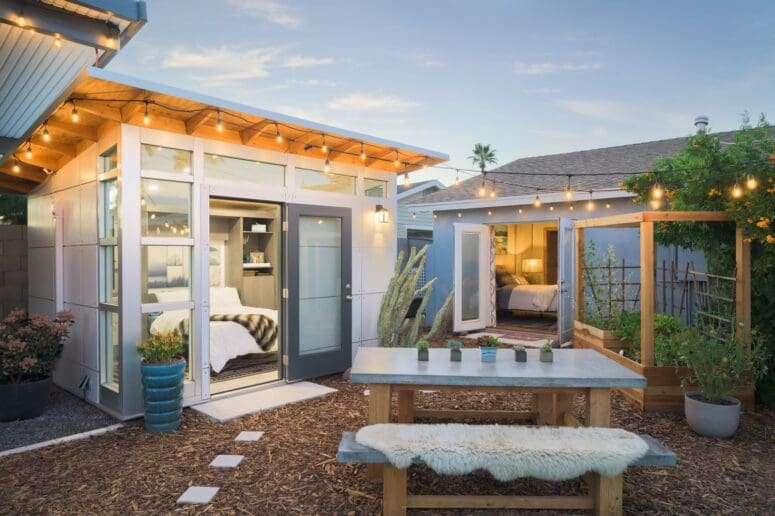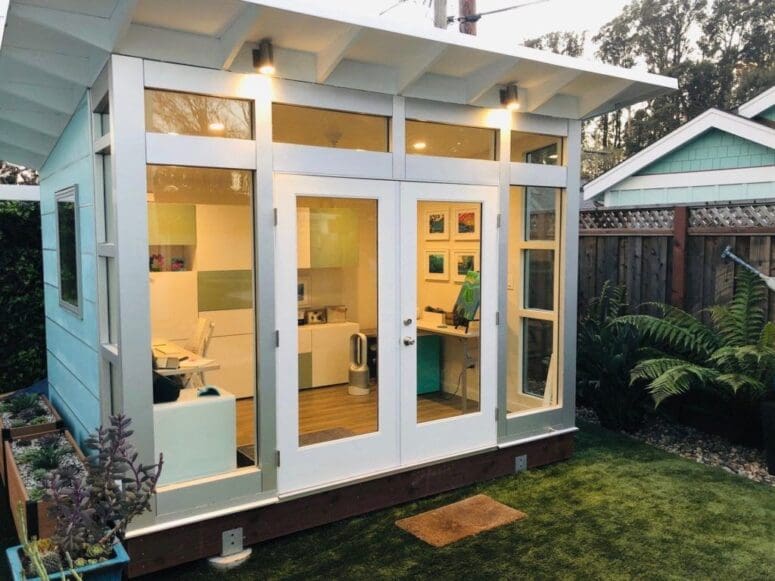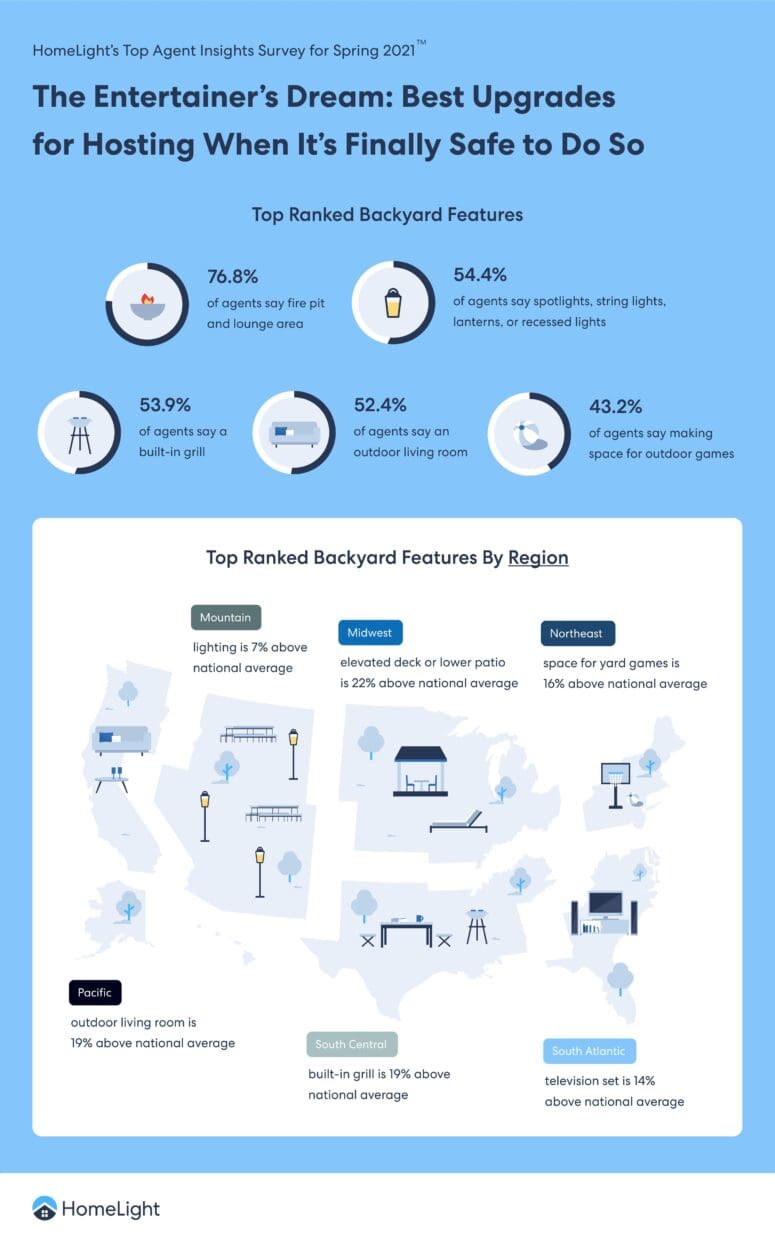WFH Forever with the Backyard Office of Your Dreams
- Published on
- 8 min read
-
 Allaire Conte Contributing AuthorClose
Allaire Conte Contributing AuthorClose Allaire Conte Contributing Author
Allaire Conte Contributing AuthorAllaire Conte is a writer with a passion for real estate, technology, and nature. She holds her MFA in Nonfiction Writing from Columbia University and is based in Brooklyn.
The coronavirus pandemic has led to more people working remotely than ever, with 42% of the U.S. labor force working from home full-time. Not only have employees grown accustomed to the five-second commute, but employers are seeing increased employee productivity and saving on brick-and-mortar costs. With benefits like these, all signs point to working from home becoming a permanent fixture of American life. So if you’re working from home, why not invest in building the backyard office of your dreams?
A home office is now an essential part of any house, and your backyard is the perfect space to build your personal HQ. But before you build, do your research. Not all backyard offices are equal in the eyes of future buyers or the appraiser. And design-wise, there’s plenty more to consider than the lumbar support in your desk chair. We spoke to leading industry experts to bring you the lowdown on how to make your new home office work for you.
To add-on or build-out: that is the question
Of the top six ways that COVID-19 will change real estate forever, there is a common theme: space. Homeowners and buyers alike want more of it, and if you’re considering adding a home office, space is a vital consideration. We broke down some of the most popular options to fit an office in whatever available space your home offers.

Sunroom
Three- or four-season rooms (aka sunrooms) aren’t just a place to bask in the sun from the comfort of the great indoors anymore. These classic additions are gaining popularity for the workweek warrior looking for a room to call their own. This may be in large part because sunrooms are low-cost and relatively fast to build.

Costs
Expect to spend anywhere from $5,000 to north of $25,500 on this addition. For homes in mild climates, simple patio enclosures are the cheapest addition, averaging $8,000. If you live in a less temperate climate, you will likely need the additional insulation of a four-season room, which can average anywhere from $25,000 to $80,000 or more. Alternatively, you can purchase a prefabricated kit for a low-cost solution that you can complete in two to four weeks.
Considerations
Whether designing from scratch or constructing a prefab, this is your chance to create the ideal office environment for yourself. Ask yourself what conditions you are most comfortable in, then optimize your space with those features. Temperature control and Wi-Fi are the most important considerations:
- Temperature control: While you might be able to get by during the warm months with a fan in the rest of your house, remember that you’ll be working in this space. The U.S. Occupational Safety and Health Administration recommends keeping office temperatures at 68 to 76 degrees Fahrenheit. Depending on where you live, you may need an HVAC system to keep your space optimized for productivity.
- Wi-Fi: Since sunrooms are attached to the home, you can likely pick up your Wi-Fi signal from this home office addition. The real question, though, is: Do you want to? An easy upgrade for your home office is to purchase a separate internet modem. This allows for lightning-fast speed and no disruptions to your connection. If that feels like overkill, try a Wi-Fi extender; these easy-to-use devices are a cheaper solution to dead zones.
It isn’t always sunny in a four-season room, though — these additions do come with some drawbacks. Homeowners can expect a 50% return on investment; not a bad ROI but considerably less than some other options explored below.
Additionally, you should take glare into consideration when orienting your desks, as sunrooms are designed to optimize sunlight, not productivity. You can reduce glare with solar shades or anti-glare film for computers, but glare could be a deal-breaker for workers with more sensitive eyes.
Lastly, because these rooms are an extension of your home, at-home office workers may still feel distracted by the hustle and bustle of homelife.

Studio shed additions
Expert Bay Area agent Rick Fuller, who has over 18 years of experience and has sold 96% of his listings, says, “What we find is the most popular and the most desirable option is often the prefabricated ADUs … because they’re more cost-effective.” And the numbers support Fuller’s findings: Sales of prefab backyard offices went through the roof in 2020 and are projected to continue in 2021.
These small accessory dwelling units, or ADUs, are manufactured in a warehouse, shipped nationwide, and built on-site. They offer the best of both worlds when it comes to home additions: They’re removed from the home’s premises and run off of the house’s utilities, making for easy installation and maximum additional space.
The timeline to complete this project depends on building permits, but once you secure the permit (if necessary), the turnaround time is typically four to six weeks.
Costs
Creative Director and Co-Founder of Studio Shed, Jeremy Nova, says that a single-room studio will cost buyers around $30,000. This includes the price of materials, shipping, white-glove installation, and utility hook-up. Larger units run anywhere from $100 to $140 per square foot.
A popular way to save on costs is to go the DIY route. Nova says that some prefer to construct their Studio Shed themselves: “It’s not like putting together an IKEA coffee table but if you know your way around standard home improvement tools, it’s something a lot of our customers do have success with. And it’s a great way to save money.”
You might not even need to worry about cutting costs, though. Backyard studios offer great gains for homeowners. “The typical appraised value of one of our buildings is about one and a half times the retail cost of it … So, the ROI on doing the project is excellent,” Nova remarks. With returns like these, this backyard office is an easy way to maximize productivity while adding value to your home.
Considerations
“Our homes are not necessarily a sanctuary anymore,” says Nova. “The distractions of everything in the home make it a difficult place to work, or create, or pursue a hobby.” For workers who find themselves needing to get away from the commotion of domestic life while still being at home, a backyard studio is the ideal choice. Nova says his customers rave about the benefits of having a detached office: “We hear from people, ‘I do my best work in my Studio Shed, I feel more creative,’ all those kinds of things … It really does change the way we live and work.”
You can easily outfit prefab structures for year-round use. A mini-split HVAC unit is a simple addition for temperature control; but depending on where you live, you may be comfortable with a quality fan in the summer and space heater in the winter. For the best internet connection, purchase a separate internet modem.
Mobile home
Maybe you already have an RV or camper trailer living in your driveway, or maybe, you’ve always fantasized about purchasing an old-school chrome Airstream. Whatever your inspiration is, RVs and mobile homes are perfect home offices for adventurous souls.
Costs
While the caravan lifestyle may look picturesque on your Instagram, it doesn’t offer as many benefits for your wallet as a sunroom or prefab backyard office. RVs and campers are vehicles first and foremost, which means that they depreciate value like cars do, even if you’re not driving them cross country. More modest versions start around $11,000, while deluxe editions can start at $35,000.
These price points are on level with the cost of other home office additions, but unlike those additions, RVs are considered personal property, not real property, and thus, don’t add value to your home. This option may be best left as a temporary solution or for those who already have an RV and need a home office fast.
Considerations
Camper trailers offer a wide variety of barebones to luxury benefits. Any necessary upgrades — like an HVAC system or custom desk — will largely depend on the model of the trailer and the surrounding climate. While this is true of all backyard offices, RVs offer a few additional factors to consider:
- Power-source: With heating and cooling needs, lightning, internet, and device chargers, the power source for your RV or trailer office might be the most important consideration. If your office on wheels is parked in your driveway, the easiest option is to plug into your home’s power source — this will give you easy access to the power grid, and you won’t have to ration your usage. If you want to work from the road, though, you’ll need to consider your battery capacity and your plan for recharging (e.g., solar, wind, powered campground sites, or a combination).
- Wireless cellular internet: These portable internet connections are the most popular way for those on the road to stay connected. You will need to purchase an additional plan, which can come with drawbacks like annual contracts and limited service in remote areas. However, the freedom these wireless routers offer can be well worth the trouble.
The best part of an RV or trailer workplace? After spending so much of 2020 indoors, these mobile offices give workers the chance to pick up and take their work anywhere — just make sure to get the clear from HR first.

Patio office
If you live in a temperate climate or want to make the most of your hometown’s fleeting good weather, move your office outside entirely. Not only is this an affordable option, but studies show that more time outdoors is linked to an improved sense of well-being.
Costs
If you already have a patio area, this office space is likely the most cost-effective option. All you need is some comfortable patio furniture, a patio cover, and a strong Wi-Fi connection. If you don’t already have a patio cover, it can cost as little as $300 to $700 to add a canvas awning.
While a patio office may be one of the cheapest options on the list, it offers little return on investment. With the working from home boom, many buyers prefer a dedicated indoor office space that can be used rain, shine, sleet, or snow. Furthermore, according to the National Association of Realtors, patio projects typically recoups about 67% of project costs — a solid return, but still lower than the potential ROI of an ADU home office solution.
Considerations
Patio offices don’t have to be a stand-alone solution —they are a great addition to any home office. Nova says Studio Sheds and the like offer a unique opportunity for this additional workspace:
“People usually find that they have some kind of unused space in their backyard. And a Studio Shed can be a catalyst for more of a backyard transformation … You can create positive space, more of a courtyard between your home or your back patio [by] having a destination.”
To make a patio office work, you’ll need a shady spot to protect your computer screen from sun glare and keep your devices between 50 to 95 degrees Fahrenheit. Since the outdoors are often noisy and unpredictable, it’s best to arm yourself with a quality pair of noise-canceling headphones to help you focus.
If it’s sunny, remember to wear sunscreen, even if your workspace is mostly shaded. You might not realize that you’re catching rays while absorbed in your work, but it only takes 15 minutes to get a sunburn if the UV index is high and only 45 minutes of exposure to get a sunburn if the UV index is moderate. And don’t forget your allergy medicine — the last thing you need is a sneezing fit during your outdoor Zoom conference.

Added perks of backyard offices
Whether you’re designing your backyard office for yourself or gettig your house market-ready, include these elements to reap the maximum benefit of your new space.
Flexible design
Any home addition boils down to functionality and flexibility, especially in 2021. We’ve all had to be a little more nimble when it comes to getting things done, and the space a backyard office provides is essential to that. Outside of the 9-5 grind, backyard offices can double as home gyms, lounge areas, or even mother-in-law units. This vast potential is particularly alluring to buyers hunting in a low-inventory market.
“I’m seeing built-in bookshelves, some custom desks. I’m seeing desks that operate as a treadmill. I see stationary bikes that are located in their office. I see exercise equipment in their office … All of that can be done at home,” Fuller comments.
Fuller points out that one of the hottest emerging home office trends is hybrid exercise/office furniture like the stationary bike desk. The hype is for good reason: Not only do these furniture options provide a convenient way to stay fit, but studies show that they increase productivity and boost health.
And even though you’re working from home, remember to personalize (unless you’re looking to sell); carving out space for pictures and other nicknacks like you would in a traditional office can help you settle into your new routine.
Home office tax deduction
If you’re running your personal business from your backyard office, the cost of constructing and furnishing your headquarters might qualify for a tax write-off. For business owners, any direct expenses — like that new printer and fresh coat of paint — are 100% deductible, while things like your internet bill or security system can only reap a partial deduction. When the time comes to sell your home, employers and employees alike can write off the added value of their new backyard office with a capital gains break, so long as the added value is under the IRS threshold.
Unfortunately, the tax break doesn’t apply to company employees working from home — but check-in with HR to see if your employer offers a remote work stipend.

Contact professionals before you build a backyard office
Whichever backyard home office design best suits your needs, Fuller underlines the importance of doing it by the books: “You wanna make sure it’s done with permits so that it can add value to the property. Often, when a homeowner takes on a construction project, they don’t obtain the necessary permits, and it minimizes the value that brings to the property.”
If you’re worried about your bottom line, consult a real estate agent before you build. These experts can give insight into the most popular designs for your area, offer strategies to maximize your ROI, and advise you on what permits your project requires.
Header Image Source: (Kenny Timmer / Unsplash)

